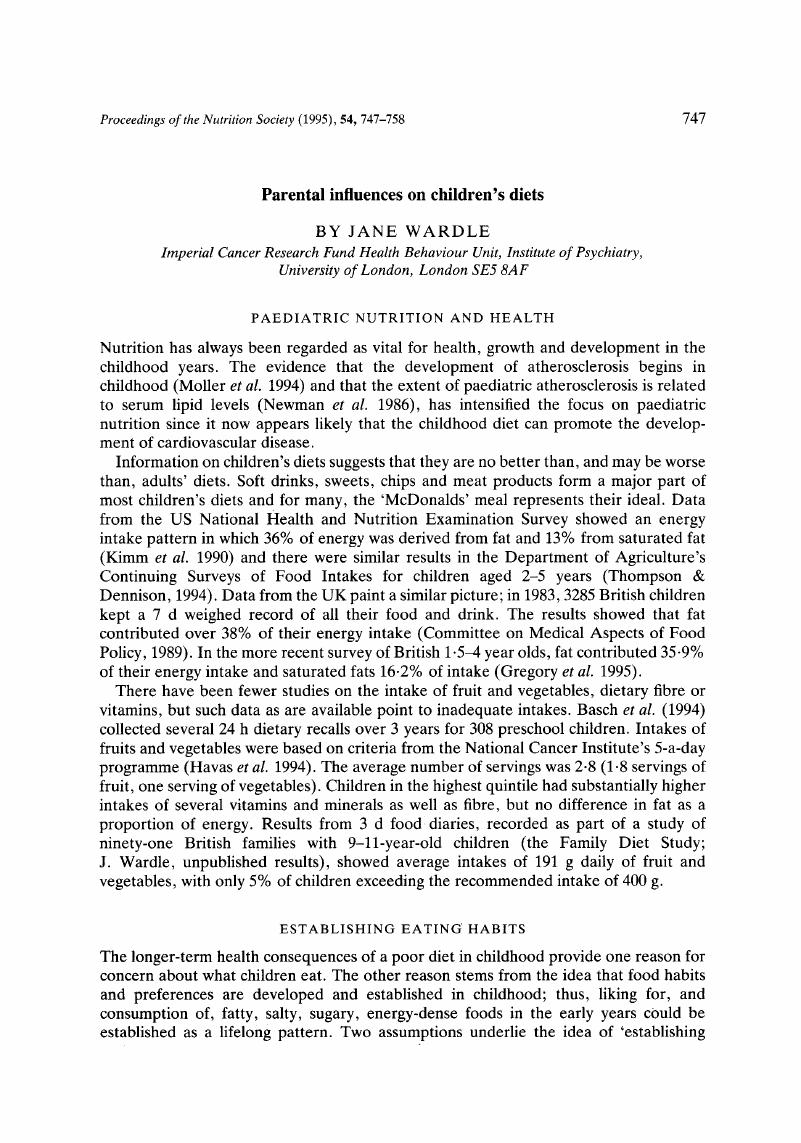Crossref Citations
This article has been cited by the following publications. This list is generated based on data provided by Crossref.
1997.
Abstracts of Communications.
Proceedings of the Nutrition Society,
Vol. 56,
Issue. 3,
p.
294A.
Gibson, Sigrid
1998.
Hypothesis: parents may selectively restrict sugar-containing foods for pre-school children with a high BMI.
International Journal of Food Sciences and Nutrition,
Vol. 49,
Issue. 1,
p.
65.
GIBSON, E.L.
WARDLE, J.
and
WATTS, C.J.
1998.
Fruit and Vegetable Consumption, Nutritional Knowledge and Beliefs in Mothers and Children.
Appetite,
Vol. 31,
Issue. 2,
p.
205.
Robinson, Thomas N.
Kiernan, Michaela
Matheson, Donna M.
and
Haydel, K. Farish
2001.
Is Parental Control over Children's Eating Associated with Childhood Obesity? Results from a Population‐Based Sample of Third Graders.
Obesity Research,
Vol. 9,
Issue. 5,
p.
306.
Lien, Nanna
Lytle, Leslie A.
and
Klepp, Knut-Inge
2001.
Stability in Consumption of Fruit, Vegetables, and Sugary Foods in a Cohort from Age 14 to Age 21.
Preventive Medicine,
Vol. 33,
Issue. 3,
p.
217.
Wardle, Jane
Sanderson, Saskia
Leigh Gibson, E.
and
Rapoport, Lorna
2001.
Factor-analytic structure of food preferences in four-year-old children in the UK.
Appetite,
Vol. 37,
Issue. 3,
p.
217.
2001.
Abstracts of Original Communications.
Proceedings of the Nutrition Society,
Vol. 60,
Issue. 4a,
p.
1A.
Adamson, A. J.
Foster, E.
Butler, T. J.
Bennet, S.
and
Walker, M.
2001.
Non‐diabetic relatives of Type 2 diabetic families: dietary intake contributes to the increased risk of diabetes.
Diabetic Medicine,
Vol. 18,
Issue. 12,
p.
984.
Hart, K. H.
Bishop, J. A.
and
Truby, H.
2002.
An investigation into school children's knowledge and awareness of food and nutrition.
Journal of Human Nutrition and Dietetics,
Vol. 15,
Issue. 2,
p.
129.
Longbottom, P. J.
Wrieden, W. L.
and
Pine, C. M.
2002.
Is there a relationship between the food intakes of Scottish 5½−8½‐year‐olds and those of their mothers?.
Journal of Human Nutrition and Dietetics,
Vol. 15,
Issue. 4,
p.
271.
Wardle, Jane
Cooke, Lucy J
Gibson, E.Leigh
Sapochnik, Manuela
Sheiham, Aubrey
and
Lawson, Margaret
2003.
Increasing children's acceptance of vegetables; a randomized trial of parent-led exposure.
Appetite,
Vol. 40,
Issue. 2,
p.
155.
Wardle, J
Herrera, M-L
Cooke, L
and
Gibson, E L
2003.
Modifying children's food preferences: the effects of exposure and reward on acceptance of an unfamiliar vegetable.
European Journal of Clinical Nutrition,
Vol. 57,
Issue. 2,
p.
341.
Burchett, Helen
2003.
Increasing fruit and vegetable consumption among British primary schoolchildren: a review.
Health Education,
Vol. 103,
Issue. 2,
p.
99.
Haas, Jennifer S.
Lee, Lisa B.
Kaplan, Celia P.
Sonneborn, Dean
Phillips, Kathryn A.
and
Liang, Su-Ying
2003.
The Association of Race, Socioeconomic Status, and Health Insurance Status With the Prevalence of Overweight Among Children and Adolescents.
American Journal of Public Health,
Vol. 93,
Issue. 12,
p.
2105.
Bere, Elling
and
Klepp, Knut-Inge
2004.
Correlates of fruit and vegetable intake among Norwegian schoolchildren: parental and self-reports.
Public Health Nutrition,
Vol. 7,
Issue. 8,
p.
991.
Adamson, Ashley J.
and
Mathers, John C.
2004.
Effecting dietary change.
Proceedings of the Nutrition Society,
Vol. 63,
Issue. 4,
p.
537.
Reimer, Kathy
Smith, Chery
Reicks, Marla
Henry, Helen
Thomas, Ruth
and
Atwell, Janine
2004.
Child-feeding strategies of African American women according to stage of change for fruit and vegetable consumption.
Public Health Nutrition,
Vol. 7,
Issue. 4,
p.
505.
2004.
Position of the American Dietetic Association: Dietary Guidance for Healthy Children Ages 2 to 11 Years.
Journal of the American Dietetic Association,
Vol. 104,
Issue. 4,
p.
660.
Lake, Amelia A
Rugg-Gunn, Andrew J
Hyland, Rob M
Wood, Charlotte E
Mathers, John C
and
Adamson, Ashley J
2004.
Longitudinal dietary change from adolescence to adulthood: perceptions, attributions and evidence.
Appetite,
Vol. 42,
Issue. 3,
p.
255.
Taylor, Lindsay J.
Gallagher, Marie
and
McCullough, Fiona S.W.
2004.
The role of parental influence and additional factors in the determination of food choices for pre‐school children.
International Journal of Consumer Studies,
Vol. 28,
Issue. 4,
p.
337.



